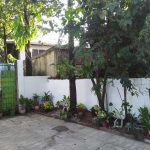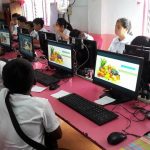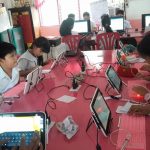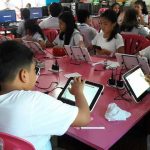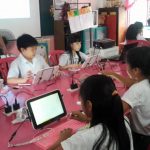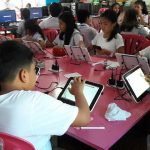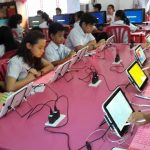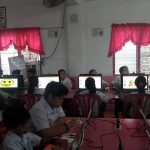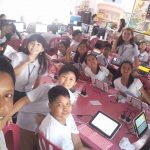DEPED LINKS
CONNECT WITH US
- email@deped.gov.ph
- (63) 2 3751995
- (63) 2 3748708
- (63) 2 3748729
SOCIAL MEDIA
BRIGADA ESKWELA
Brigada Eskwela or the National Schools Maintenance Week is a nationwide initiative by the Department of Education (DepEd) that mobilizes thousands of parents, alumni, civic groups, local businesses, non-government organizations, teachers, students, and individuals who volunteer their time and skills to do repairs, maintenance work, and clean-up of public elementary and secondary schools. This nationwide caravan is held simultaneously across the country’s 16 regions.
Smart has been a partner of DepEd for Brigada Eskwela for more than a decade, mobilizing its employees to support the facility improvement program by cleaning, repainting and repairing, gardening and landscaping and furnishing classrooms of adopted public schools. To date, Smart has mobilized close to 1,500 employees who participate in this annual activity.
GULAYAN SA PAARALAN
“Gulayan sa Paaralan” (Vegetable Gardens) is one of the strategies of the National Greening Program of the government implemented to help promote food security. This study was undertaken to determine its status five years after its implementation. Descriptive research design was used. The 242 samples were randomly selected from the list of schools implementing Gulayan sa Paaralan from the Department of Agriculture-Regional Field Unit in Region X. A survey was done in 16 elementary and six high schools of Cagayan de Oro City, Philippines. About 77% of the schools maintained vegetable gardens to serve as food basket or main source of vegetables to sustain supplementary feeding. Also, 77% of the schools surveyed used organic vegetable production. The schools taught agriculture in their Edukasyong Pantahanan at Pangkabuhayan (EPP) in the elementary schools and also in the Technology Livelihood Education (TLE) classes in the high schools. About 87% of the 220 pupils and students interviewed said that Gulayan sa Paaralan through vegetable gardening helped the school and their families economically. It is concluded that schools are still vibrant in the implementation of the program. Through the program, the pupils learned to love and appreciate the field of agriculture.
Launching Excellent Independent Successful Readers(LEISURE)
Launching Excellent Independent Successful Readers (LEISuRe) is a combination of code based and whole language reading instruction for struggling readers and those who are at risk for reading failure. It complements the classroom instruction where pupils with learning disabilities and disadvantaged background are taught on a “one-on-one” or small group instruction using the Marungko Method in Filipino and the Fuller Method in English.
Excellent Readers Around (ERA) Program was implemented in 2012 as an early intervention project to support grade one up to grade six pupils in their reading development. Different reading skills like Vocabulary development and Identification, Noting and Sequencing details, Inferences, Outcomes, Conclusions, Characterization and Sensory Impressions and Spelling and Journal Writing are among the competencies that the program desires to develop and improve among the learners. It has been implemented daily by language teachers from grades 3 to 6 during their English classes for 10-15 minutes using the Developing Reading Power (DRP) book as the reading tool.
However, teaching reading has never been easy for some children. While most children learn to read as naturally as they learn to speak, some do not. Chronic absenteeism, learning disability and low literacy households are some of the factors that affect children’s ability to learn to read. Children with learning disabilities or disadvantaged backgrounds may respond differently than a typical child. Through home visitations and interviews with the parents, it was found out that the most number of frustration and non-readers in CES are predisposed to the aforementioned factors.
According to experts, a systematic approach in teaching reading should contain two critical elements: 1.) Teaching the system of language and 2.) Linking instruction in a logical sequence throughout grades. K to 12 Curriculum is a learner centered, contextualized and content based curriculum where pupils are taught using the whole language approach in spiral progression. This is evidenced by the Teacher’s Guides being used from grades 1 to 4. Hence, the birth of the current reading program, Launching Excellent Independent Successful Readers (LEISuRe).
Phonics training has been included in the reading program to cater to struggling readers and those who are at risk for reading failure. Here, the instruction is code- based. On the one hand, pupils are given tutorial lessons in decoding and phonics to help develop their skills in sounding the consonants and eventually help them to recognize words. On the other hand, the children’s comprehension and study skills are enhanced through constant exposure to literary materials and different pre and post reading activities.
* PROJECT OBJECTIVE
Develop the children’s skill in sounding the consonants and eventually help them to recognize words.
Enhance the children’s comprehension, equip them with sufficient vocabulary, and develop their skills in recognizing and writing the letters of the alphabet.
Attain fluency and among beginning readers by means of conducting oral reading in every remedial session.
Combat the reading disabilities of pupils categorized as frustration though constant exposure to and engagement with literary materials.
Get support from the children’s household to make sure that whatever the child learns in school is being followed through at home.
* PERSONS INVOLVED
The persons responsible in undertaking the program and making it workable are the principal, the master teachers and the class advisers in all grade levels.
* PROGRAM SCHEME
Non-Readers
Teaching phonics and decoding skills
Developing Phonics Weakness
Developing Fluency
Review basic letter sounds (starting with Filipino, then moving forward to English).
Decode consonant sounds
Decode Vowel sounds
Repeated practice of the same reading text for each consonant and vowels sounds. This includes oral reading by teacher and students (in pairs or in groups).
Students read the word, spell the word and read the word again to increase high frequency word retention.
Frustration Readers
Developing Comprehension and Study Skills
Discussion of the text being read at home.
Oral reading of text (teacher guided).
Silent reading of the same text.
Enrichment Exercises (Pre and post reading activities)
Assigning of story book to be read at home with the help of their parents and/or guardians
* MATERIALS
DOLSCH Basic Sight Words
Fry Words
Flash cards (letter, words)
Task sheets
Story books, DRP
Marungko and Fuller Modules Right into Reading
* MONITORING & EVALUATION TOOLS
Phil-IRI Pre and Post Test/ Oral Reading Progress Quarterly Report.
* EXPECTED OUTCOME
By the end of their grade level or even earlier, struggling and disadvantaged children will be able to read with comprehension in both Filipino and English. Furthermore, they will be equipped with study skills that will enable them to cope up with and to achieve the goal of reading in the next grade level.
L.I.F.T - Learning Is Fun with Technology
(School Curriculum Intervention)
Project Rationale:
Concepcion Elementary school was established in 1952-1953 academic year. Since then, the printed materials have been used as the basic educational technology. Besides printed materials, radio and television technology have been used as the supportive technologies. Computer Technology Aided Learning has also added to the system since school year 2000.
An old adage states: “Tell me and I forget, show me and I remember, involve me and I understand.” This is the essence of project LIFT (Learning Is Fun with Technology).
Watching Television is natural mostly for Filipinos, especially children. Project LIFT uses this technology to facilitate learning.
Individuals are in need of different style in education. As the present situation cannot meet this need, it is necessary to provide mass education by individual and free learning by developing new opportunities.
New options must make the insufficiency of traditional educational practices disappear.
New models must give opportunities to learners of the present education system.
New opportunities must provide all individuals equality in education.
For these various reasons use of television has been increasing from day to day by large audiences. It makes television inevitable in the practice of classroom education field in the Philippines as a developing country. Using of these technologies should take into account the target community. In other words, the best technology to provide all individuals equal opportunities is radio-television technology. This is the main reason that television, a more advantageous technological tool than radio with its audio-visual facilities, is being used non-stop and is improving in each project of the Concepcion Elementary School Faculty.
Objectives:
Television, which has an important place in mass communication, has a significant role in classroom education with its special position, the way of presentation and qualities peculiar to itself.
Technological developments in the field of communication can be adapted in the field of education as it is adapted to many fields of life. Thanks to the new technologies available in this field and the advantages they provide, television can already be seen as an outdated tool. Yet as long as the opportunities it provides still keep its validity, television technology is not far from the new developments.
Supporting and Enhancing Teaching
Instructing
Explaining and Clarifying
Summarizing
Reinforcement
Motivation and Encouragement
Using as Supplementary for the other materials
Imposing study speed ( determining rate of study)
Presenting a reference to large masses
Changing behavior- Pupils become more attentive and focus on the lesson.
Presenting unreachable facts and events
Of these special features, perhaps the most important one is that television is a very familiar and attractive source from the point of view of pupils. It is also part of our daily life.
L.I.F.T – Learning Is Fun with Technology
(School Curriculum Intervention)
Project Rationale:
Concepcion Elementary school was established in 1952-1953 academic year. Since then, the printed materials have been used as the basic educational technology. Besides printed materials, radio and television technology have been used as the supportive technologies. Computer Technology Aided Learning has also added to the system since school year 2000.
An old adage states: “Tell me and I forget, show me and I remember, involve me and I understand.” This is the essence of project LIFT (Learning Is Fun with Technology).
Watching Television is natural mostly for Filipinos, especially children. Project LIFT uses this technology to facilitate learning.
Individuals are in need of different style in education. As the present situation cannot meet this need, it is necessary to provide mass education by individual and free learning by developing new opportunities.
New options must make the insufficiency of traditional educational practices disappear.
New models must give opportunities to learners of the present education system.
New opportunities must provide all individuals equality in education.
For these various reasons use of television has been increasing from day to day by large audiences. It makes television inevitable in the practice of classroom education field in the Philippines as a developing country. Using of these technologies should take into account the target community. In other words, the best technology to provide all individuals equal opportunities is radio-television technology. This is the main reason that television, a more advantageous technological tool than radio with its audio-visual facilities, is being used non-stop and is improving in each project of the Concepcion Elementary School Faculty.
Objectives:
Television, which has an important place in mass communication, has a significant role in classroom education with its special position, the way of presentation and qualities peculiar to itself.
Technological developments in the field of communication can be adapted in the field of education as it is adapted to many fields of life. Thanks to the new technologies available in this field and the advantages they provide, television can already be seen as an outdated tool. Yet as long as the opportunities it provides still keep its validity, television technology is not far from the new developments.
Supporting and Enhancing Teaching
Instructing
Explaining and Clarifying
Summarizing
Reinforcement
Motivation and Encouragement
Using as Supplementary for the other materials
Imposing study speed ( determining rate of study)
Presenting a reference to large masses
Changing behavior- Pupils become more attentive and focus on the lesson.
Presenting unreachable facts and events
Of these special features, perhaps the most important one is that television is a very familiar and attractive source from the point of view of pupils. It is also part of our daily life.









